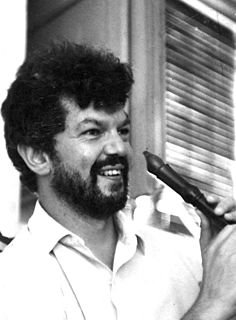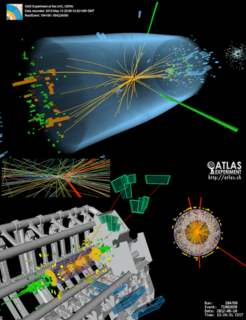Related Research Articles

A Grand Unified Theory (GUT) is a model in particle physics in which, at high energies, the three gauge interactions of the Standard Model comprising the electromagnetic, weak, and strong forces are merged into a single force. Although this unified force has not been directly observed, many GUT models theorize its existence. If unification of these three interactions is possible, it raises the possibility that there was a grand unification epoch in the very early universe in which these three fundamental interactions were not yet distinct.

The Standard Model of particle physics is the theory describing three of the four known fundamental forces excluding gravity in the universe and classifying all known elementary particles. It was developed in stages throughout the latter half of the 20th century, through the work of many scientists worldwide, with the current formulation being finalized in the mid-1970s upon experimental confirmation of the existence of quarks. Since then, proof of the top quark (1995), the tau neutrino (2000), and the Higgs boson (2012) have added further credence to the Standard Model. In addition, the Standard Model has predicted various properties of weak neutral currents and the W and Z bosons with great accuracy.

Spontaneous symmetry breaking is a spontaneous process of symmetry breaking, by which a physical system in a symmetric state spontaneously ends up in an asymmetric state. In particular, it can describe systems where the equations of motion or the Lagrangian obey symmetries, but the lowest-energy vacuum solutions do not exhibit that same symmetry. When the system goes to one of those vacuum solutions, the symmetry is broken for perturbations around that vacuum even though the entire Lagrangian retains that symmetry.

Peter Ware Higgs is a British theoretical physicist, Emeritus Professor in the University of Edinburgh, and Nobel Prize laureate for his work on the mass of subatomic particles.

In particle physics, a gauge boson is a bosonic elementary particle that acts as the force carrier for elementary fermions. Elementary particles, whose interactions are described by a gauge theory, interact with each other by the exchange of gauge bosons, usually as virtual particles.

The Minimal Supersymmetric Standard Model (MSSM) is an extension to the Standard Model that realizes supersymmetry. MSSM is the minimal supersymmetrical model as it considers only "the [minimum] number of new particle states and new interactions consistent with phenomenology". Supersymmetry pairs bosons with fermions, so every Standard Model particle has a superpartner yet undiscovered. If discovered, such superparticles could be candidates for dark matter, and could provide evidence for grand unification or the viability of string theory. The failure to find evidence for MSSM using the Large Hadron Collider has strengthened an inclination to abandon it.

In the Standard Model of particle physics, the Higgs mechanism is essential to explain the generation mechanism of the property "mass" for gauge bosons. Without the Higgs mechanism, all bosons (one of the two classes of particles, the other being fermions) would be considered massless, but measurements show that the W+, W−, and Z0 bosons actually have relatively large masses of around 80 GeV/c2. The Higgs field resolves this conundrum. The simplest description of the mechanism adds a quantum field (the Higgs field) that permeates all Hilbert spaces of the Standard Model. Below some extremely high temperature, the field causes spontaneous symmetry breaking during interactions. The breaking of symmetry triggers the Higgs mechanism, causing the bosons it interacts with to have mass. In the Standard Model, the phrase "Higgs mechanism" refers specifically to the generation of masses for the W±, and Z weak gauge bosons through electroweak symmetry breaking. The Large Hadron Collider at CERN announced results consistent with the Higgs particle on 14 March 2013, making it extremely likely that the field, or one like it, exists, and explaining how the Higgs mechanism takes place in nature. The view of the Higgs mechanism as involving spontaneous symmetry breaking of a gauge symmetry is technically incorrect since by Elitzur's theorem gauge symmetries can never be spontaneously broken. Rather, the Fröhlich–Morchio–Strocchi mechanism reformulates the Higgs mechanism in an entirely gauge invariant way, generally leading to the same results.
In particle physics, preons are point particles, conceived of as sub-components of quarks and leptons. The word was coined by Jogesh Pati and Abdus Salam, in 1974. Interest in preon models peaked in the 1980s but has slowed, as the Standard Model of particle physics continues to describe physics mostly successfully, and no direct experimental evidence for lepton and quark compositeness has been found. Preons come in four varieties, plus, anti-plus, zero and anti-zero. W bosons have six preons and quarks have only three.
The Alternative models to the Standard Higgs Model are models which are considered by many particle physicists to solve some of the Higgs boson's existing problems. Two of the most currently researched models are quantum triviality, and Higgs hierarchy problem.

This article describes the mathematics of the Standard Model of particle physics, a gauge quantum field theory containing the internal symmetries of the unitary product group SU(3) × SU(2) × U(1). The theory is commonly viewed as describing the fundamental set of particles – the leptons, quarks, gauge bosons and the Higgs boson.

A scalar boson is a boson whose spin equals zero. Boson means that the particle's wave function is symmetric under particle exchange and therefore follows Bose–Einstein statistics. The spin-statistics theorem implies that all bosons have an integer-valued spin; the scalar fixes this value to zero.
In particle physics, the hidden sector, also known as the dark sector, is a hypothetical collection of yet-unobserved quantum fields and their corresponding hypothetical particles. The interactions between the hidden sector particles and the Standard Model particles are weak, indirect, and typically mediated through gravity or other new particles. Examples of new hypothetical mediating particles in this class of theories include the dark photon, sterile neutrino, and axion.

François, Baron Englert is a Belgian theoretical physicist and 2013 Nobel prize laureate.

Robert Brout was an American theoretical physicist who made significant contributions in elementary particle physics. He was a professor of physics at Université Libre de Bruxelles where he had created, together with François Englert, the Service de Physique Théorique.

The Higgs boson, sometimes called the Higgs particle, is an elementary particle in the Standard Model of particle physics produced by the quantum excitation of the Higgs field, one of the fields in particle physics theory. In the Standard Model, the Higgs particle is a massive scalar boson with zero spin, even (positive) parity, no electric charge, and no colour charge, that couples to mass. It is also very unstable, decaying into other particles almost immediately.
The 1964 PRL symmetry breaking papers were written by three teams who proposed related but different approaches to explain how mass could arise in local gauge theories. These three papers were written by: Robert Brout and François Englert; Peter Higgs; and Gerald Guralnik, C. Richard Hagen, and Tom Kibble (GHK). They are credited with the theory of the Higgs mechanism and the prediction of the Higgs field and Higgs boson. Together, these provide a theoretical means by which Goldstone's theorem can be avoided. They show how gauge bosons can acquire non-zero masses as a result of spontaneous symmetry breaking within gauge invariant models of the universe.

Superfluid vacuum theory (SVT), sometimes known as the BEC vacuum theory, is an approach in theoretical physics and quantum mechanics where the fundamental physical vacuum is viewed as superfluid or as a Bose–Einstein condensate (BEC).
In theoretical physics, a mass generation mechanism is a theory that describes the origin of mass from the most fundamental laws of physics. Physicists have proposed a number of models that advocate different views of the origin of mass. The problem is complicated because the primary role of mass is to mediate gravitational interaction between bodies, and no theory of gravitational interaction reconciles with the currently popular Standard Model of particle physics.
In particle physics, composite Higgs models (CHM) are speculative extensions of the Standard Model (SM) where the Higgs boson is a bound state of new strong interactions. These scenarios are models for physics beyond the SM presently tested at the Large Hadron Collider (LHC) in Geneva.
References
- ↑ Gunion, John; Haber, Howard; Kane, Gordon; Dawson, Sally (2000). The Higgs Hunter's Guide (illustrated, reprint ed.). Westview Press. ISBN 9780738203058.